Driver updater apps make it easier to keep your system stable, but the real challenge is picking the right one.
In this Avast Driver Updater vs IObit Driver Booster comparison, I tested both on the same PC, from scan speed to backup options, to see which tool you can actually trust.
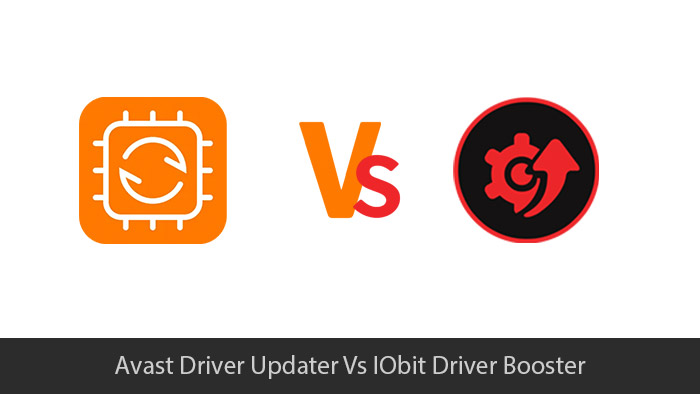
Avast Driver Updater Vs IObit Driver Booster: Overview
Before diving deep into the comparison, let's look at the applications individually.
Parameters | Avast Driver Updater | IObit Driver Booster |
|---|---|---|
Pricing Options | ||
Interface | ||
Scanning Speed | ||
Auto Scan and Update | ||
Backup & Restore | ||
WHQL Certification | ||
Additional Features | ||
Support | ||
Performance | ||
Privacy & Data Sharing |
Winner
IObit Driver Booster Pro
Scores: 9/10
Avast Driver Updater
Avast, a popular name in the antivirus industry, does not just stop at security solutions. Over the years, it has launched different tools to maintain your system's overall well-being. Avast Driver Updater is one such tool that promises smoother performance and a more stable system by installing the latest driver version.
The program utilizes its vast driver database to find outdated or missing drivers on your PC and replace them with updated ones. Additionally, its sleek and clean user interface proves to be an edge, allowing you to easily scan, search, and update drivers without requiring you to be a tech wizard. See our detailed Avast Driver Updater Review.
Driver Booster
On the other hand, when it comes to powerful PC optimization tools, IObit excels in this segment, including Driver Booster. The program efficiently scans your PC and updates everything with just a single click. It also focuses on smoothing your gaming performance, fixing faulty drivers, creating backup and restore points for peace of mind, and much more. All of this while keeping your system stability a priority.
In short, while IObit Driver Booster might not have the same brand recognition as Avast's, it still stands strong as a powerful driver management utility. It makes driver updates simple and safe. Read our full Driver Booster Review.
Warning
Though driver updater tools help enhance system performance, they come with a few risks. Sometimes installing a new driver can cause crashes, instability, and other PC issues. Hence, always create a backup of your current driver before installation. It ensures you can revert your system to its previous healthy state if anything goes sideways.
So on paper, both look capable, but their real differences show up only when you put them to the test.
Pricing
Avast Driver Updater Pricing
- Official price: USD 43.99 per year
- PCs Covered: 1 Windows PC
Avast Driver Updater comes with a 30-day fully functional trial. After the trial ends, a paid subscription is required.
IObit Driver Booster Pro Pricing
- Official prices
- 3 PCs, 1 Year: USD 74.85
- 3 PCs, 2 Years: USD 179.94
- 5 PCs, 1 Year: USD 124.75
- PCs Covered: Upto 5 Windows PCs
It comes with both a free version and a free trial of the Pro version. During the 14-day trial, you can only update one driver per day. Learn more about the Driver Booster Free vs Pro version.
Impression: Avast costs almost double compared to Driver Booster. Also, Avast Driver Updater covers only one Windows PC, whereas IObit Driver Booster supports upto 5 PCs.
IObit Driver Booster
Pricing Verdict
If you're looking for a budget-friendly driver updater with multi-PC support, IObit Driver Booster clearly wins the pricing battle.
For the latest prices, refer to the official Avast and IObit Websites. Using our Driver Booster Coupon codes and Avast Driver Updater coupons, you can get them at lower prices.
Avast Driver Updater Vs Driver Booster: Quick Comparison Table
Let's compare the features of both apps quickly below.
Features | Avast Driver Updater | IObit Driver Booster |
|---|---|---|
Scan Speed | 3.99 seconds | 3.87 seconds |
Auto Scan | Yes (every 7 days) | Yes (Customizable) |
Auto Update | No (manual approval needed) | Yes (Pro feature, optional) |
Free Version Availability | No | Yes (with limitations) |
Driver Database Size | 130 Million+ | 18 Million+ |
Offline Driver Updater | No | Yes |
Backup and Restore | Yes | Yes |
Roll Back | Yes (only for drivers updated via Avast) | Yes (Available for most of the drivers) |
Ignore Driver | Yes (offers both “Ignore driver” and “Skip update”) | Yes (has an Ignore List) |
Additional Tools | Alternative drivers, Auto delete backups, Skip driver update option | Offline Driver Updater, Game Boost, Fix incompatible driver |
Supports ARM64 (64-bit ARM processor) devices | No | Yes (Supports Windows 11/10 on ARM64 Devices, covering 100,000+ ARM drivers) |
Driver Sources (WHQL certified) | Yes (Not consistent) | Yes (consistent) |
Feature Comparison
Below is an elaborate comparison of the features Avast Driver Updater Vs IObit Driver Booster offer.
Scan and Update Drivers
It is the core feature of both Avast Driver Updater and Driver Booster.
Scanning Speed
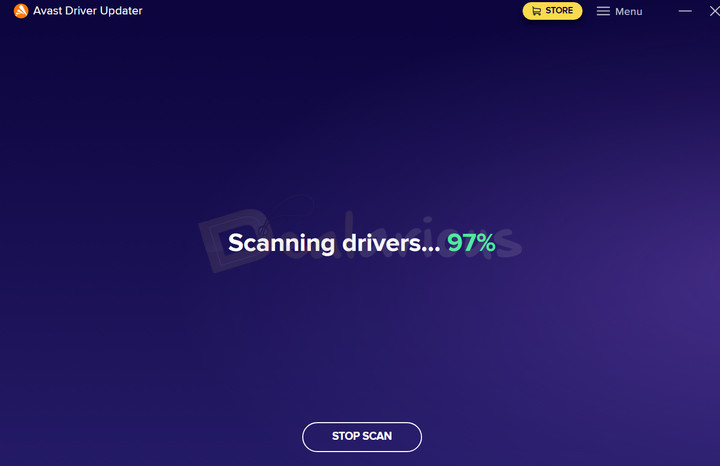
In my test, both apps were lightning quick. Driver Booster finished the scan in 3.87 seconds, while Avast wrapped up in 3.99 seconds. Please note that the scan speed also depends on your overall Internet speed.
That’s just a fraction of a second apart, and honestly, you won’t notice the difference. The scan window barely has time to show progress before it’s done.
DRAW
Scanning Speed Verdict
When it comes to scanning speed, there’s no real winner. Both tools are fast enough that speed won’t ever be the deciding factor. What matters more is what they actually detect after the scan.
Drivers Detected and Accuracy
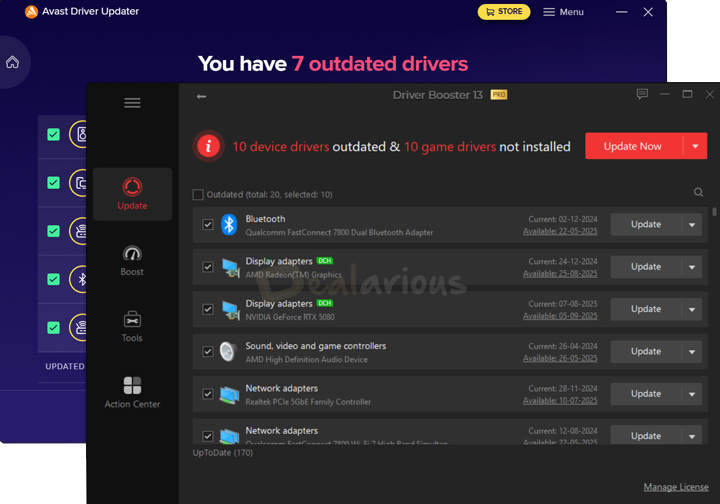
On my test system, Avast Driver Updater flagged 7 outdated drivers. It stuck to the basics — graphics, audio, and network. These are the core drivers that matter most for system stability. Nothing extra, nothing confusing.
Driver Booster, on the other hand, came back with 10 device drivers plus another 10 game components. Along with the core updates, it pulled in extras like redistributables (that games usually install anyway), a system optimizer (AMD 3D V-Cache), and one AMD security driver. Handy if you’re gaming, but not really essential for everyday use.
User Choice
Drivers detected & Accuracy Verdict
Avast keeps things lean and simple. Driver Booster digs deeper, which can help gamers, but may feel like extra noise for regular users.
Automatic Scanning and Update
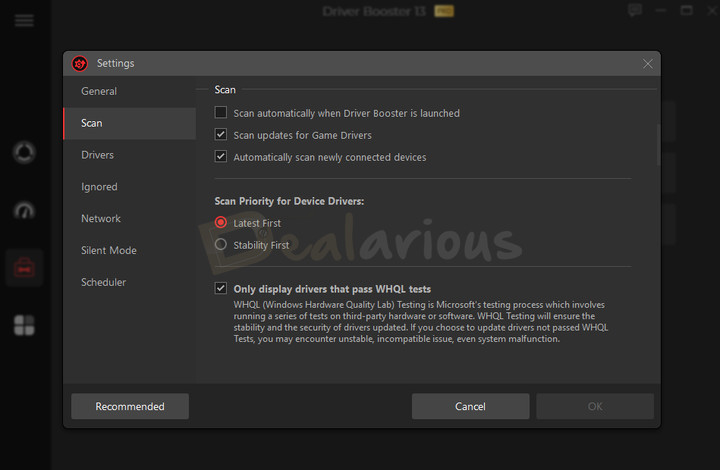
Avast Driver Updater automatically scans your system every 7 days for the latest drivers and notifies you. However, it does not automatically update the drivers without your permission.
IObit Driver Booster also includes automatic scan and update options, but with some added enhancements. With Driver Booster Pro, you can choose between 'Latest First' or 'Stability First' scan priorities, schedule scans daily, weekly, biweekly, or monthly, and enable or disable automatic updates, which Avast Driver Updater lacks. This flexibility makes Driver Booster more appealing for users who like fine-tuning updates.
Tip: When using IObit Driver Booster Pro, I suggest setting your preferences to Auto Scan + Manual updates from the Settings menu. These settings keep you in control of what gets updated and minimize the risk of installing unnecessary drivers.
IObit Driver Booster
Auto Scan & Update Verdict
While both tools offer fast scanning, Driver Booster wins this round by adding customizable scan schedules and optional automatic driver updates. It gives you greater control over how you want the program to function.
Backup and Restore
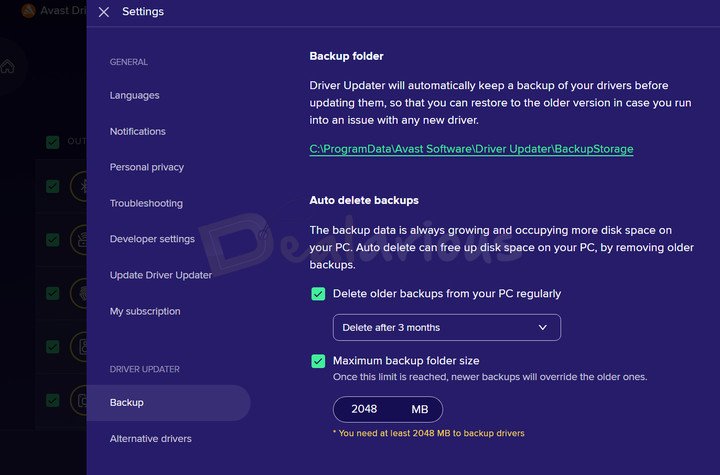
Driver updates can sometimes cause system issues (e.g., BSOD, crashes, malfunctions, etc). Hence, to prevent such critical situations, both Avast Driver Updater and Driver Booster allow you to create driver backups before new updates are installed. If you face any challenges after the new update, you can quickly restore to the previous stable version with both tools.
- Avast Driver Updater automatically saves a backup of the drivers before installing them. The backup process applies to all drivers listed in the program.
- With Driver Booster, you can backup drivers manually or set automatic backups before every driver installation.
Note: The automatic driver backup feature is exclusive to IObit Driver Booster Pro users.
Rollback
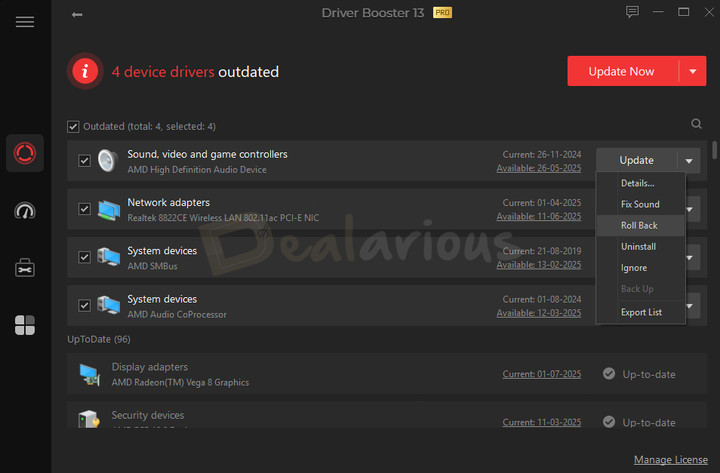
Rollback is slightly different from restore. Instead of restoring from a backup file, it lets you directly revert to the previous driver version.
Both tools take a slightly different approach when it comes to rolling back drivers.
- Avast Driver Updater can only revert a driver if it was previously updated with Avast itself. If a driver was installed/updated by Windows Update or other third-party apps, the program can not roll back the drivers.
- IObit Driver Booster Pro shows which drivers in the list can be rolled back. In my testing, it displayed a rollback option for a driver, despite the fact that I never updated or created a backup of the driver using the program.
IObit Driver Booster
Backup and Restore Verdict
Both tools make driver updates safer by creating backups and offering restore points. However, Avast Driver Updater reverts only the drivers it updated. In contrast, IObit Driver Booster Pro takes the lead by rolling back any driver to a previous version in its database. It includes Windows drivers and other manufacturers like Microsoft, Intel, Nvidia, and AMD.
WHQL Certification
WHQL (Windows Hardware Quality Labs) is a driver testing process by Microsoft that validates a driver's stability and compatibility with the Windows OS. Drivers that pass this test acquire a digital signature from Microsoft confirming that they have been rigorously tested, enhancing their reliability as stable drivers.
Avast Driver Updater scans your system against its 130 million driver database from 1300+ verified hardware manufacturers. As a result, you get better hardware coverage, faster detection, and better chances of finding drivers for rare or old devices.
Even though Avast Driver Updater uses a thorough filtering process to ensure only compatible and verified drivers reach you for update, it does not consistently provide WHQL-certified drivers.
Note: When asked about WHQL certification, Avast’s support clarified:
While Avast Driver Updater does offer WHQL-certified drivers, it does not explicitly guarantee them with every driver update.
IObit Driver Booster, in contrast, has an 18 million+ driver database from 1200+ verified manufacturers. However, what makes it effective is that the program applies strict filtering rules, only offering WHQL-certified and IObit-tested drivers. Driver Booster's driver updates come directly from official manufacturers or Microsoft. Unlike Avast, Driver Booster clearly displays WHQL certification in the driver details for transparency.
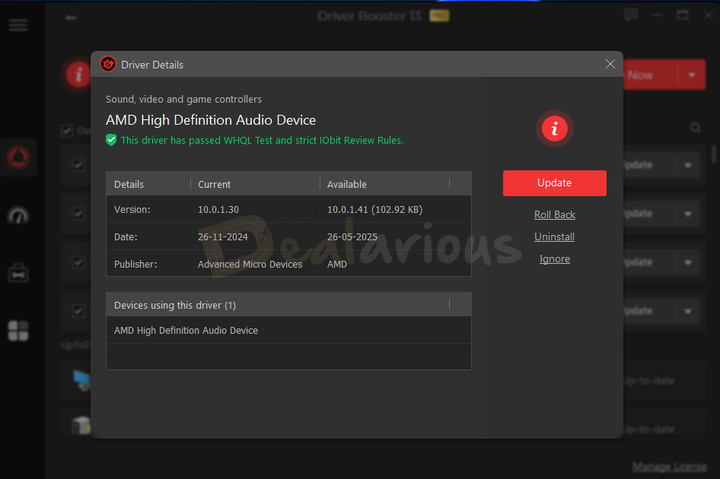
IObit Driver Booster
Certification Verdict
With consistent WHQL-certified drivers and full transparency, Driver Booster wins this segment.
Additional Tools
Besides offering standard driver management tasks, both tools pack a few extra features.
Avast Driver Updater Additional Features
The program offers 3 additional features:
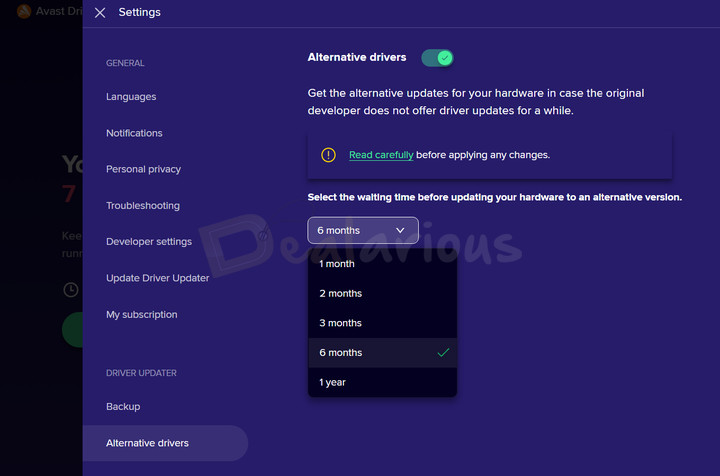
Alternative Drivers: Located in the Settings menu, this feature lets you set different frequencies to look for safe alternative drivers, in case the device manufacturer has not released new updates for a while.
Auto Delete Backups: To free up unnecessary disk space, the program deletes older driver backups once your folder reaches its predefined size limit.
Skip driver update: This feature allows you to bypass the current driver update, but will notify you when a newer version becomes available.
While the list is short, the Alternative setting stood out to me. It lets you define how often Avast should check for safer alternatives — useful if you’re dealing with stubborn manufacturer delays.
Driver Booster Additional Features
When it comes to offering extra features, IObit Driver Booster packs more than Avast Driver Updater.
Game Boost: Allows you to enjoy a smooth gaming session by stopping processes and services of your choice.
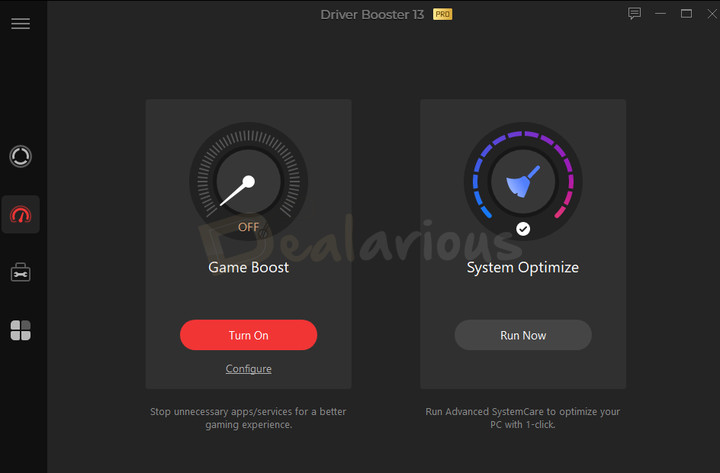
In addition to Game Boost, the Boost tab also includes a System Optimization feature powered by IObit Advanced SystemCare (Read Review). If it is already installed, you can click 'Run Now' to optimize your system.
Fix faulty drivers: During a scan, Driver Booster identifies faulty drivers present in your system and provides you with a dedicated option to repair them.
Fix system issues: Available with the Driver Booster Pro plan, the program lets you resolve common PC problems caused by driver issues. These include no sound, bad resolution, network failure, device error, and incompatible drivers.
Advanced customization: IObit Driver Updater offers flexibility to customize different settings to get the best driver update possible without jeopardizing your system stability.
Silent Mode: When enabled, this feature minimizes interruptions during a work session by stopping Driver Updater's notifications.
Offline Driver Updater: Download and install the latest driver updates without requiring an active internet connection. This feature is particularly helpful if you are facing network driver issues or need to reinstall Windows.
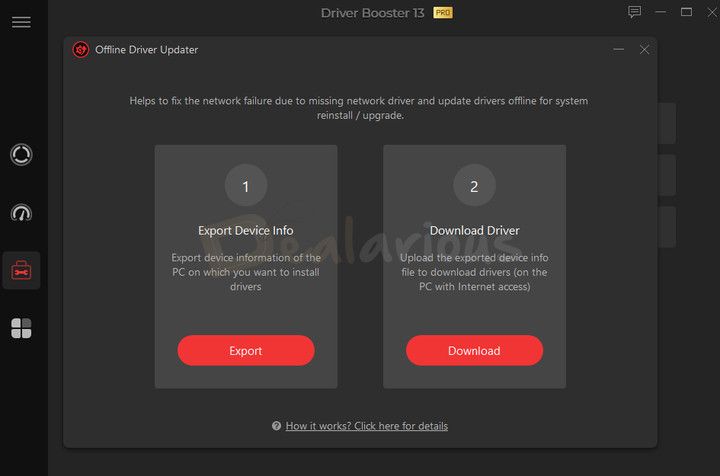
IObit Driver Booster
Additional Features Verdict
Driver Booster clearly takes the lead in this round. With its helpful offline driver updater feature, dedicated driver repair tool, and flexible customization options, the program outperforms Avast Driver Updater.
Interface
The interface is another major part of any software that is supposed to simplify a task that the user is trying to achieve. During my Avast Driver Updater Vs IObit Driver Booster comparison tests, they aced this regard. Both tools have a clean and intuitive user interface, making it easy for any user to quickly update their driver.
Avast Driver Updater Interface
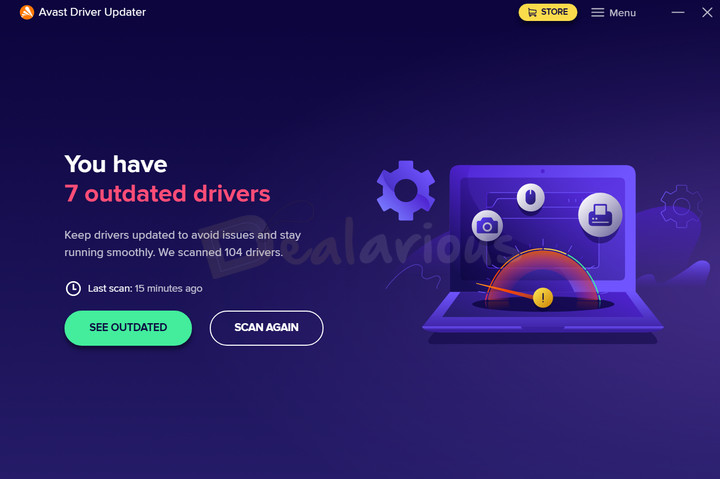
Avast Driver Updater makes updating drivers smooth and easy with just one or two clicks. Upon launching the program for the first time, it asks you to run a scan, after which it lists all the available and outdated drivers in a clear view for easy recognition. The main window displays two prominent buttons:
- See Outdated
- Scan Again.
The navigation is direct without any extra clutter to get lost in. It also features a filter option that allows you to select specific categories of drivers (e.g., Audio, Bluetooth, Biometric, Battery, Display, etc.) for quick access.
Driver Booster Interface
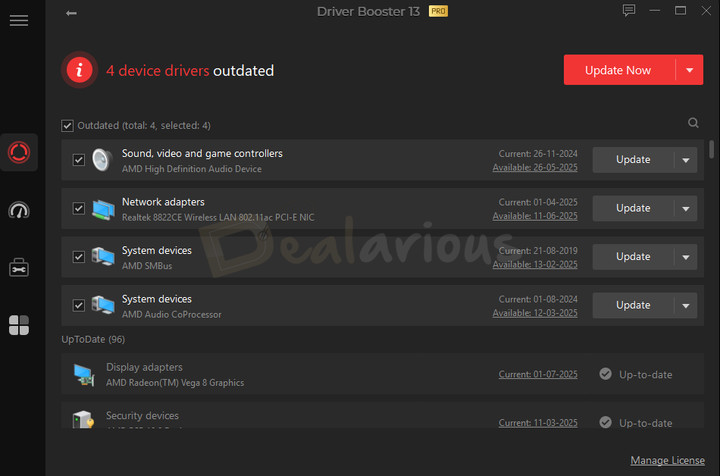
On the other hand, IObit Driver Booster packs a well-organized interface. Right when you launch the program, you are presented with a large Scan button allowing you to check on all your system drivers. Similar to Avast Driver Updater, the scan result lists all the outdated and updated drivers present in your PC. However, what differs is that beside each listed driver, the program offers a status indication of issues (e.g., faulty driver, not installed, missing drivers, and outdated drivers).
The left sidebar features four tabs: Update, Boost, Tools, and Action. Each tab takes you to its respective page. Another small but clever addition that I liked is the floating panel on the right side of the main window that displays your detailed PC information. This is helpful if you'd like to dig deeper into your system stats before updating anything.
DRAW
Interface Verdict
While Driver Booster offers organization, Avast Driver Updater focuses on minimalism. At the end, both delivered equally user-friendly interfaces in terms of ease of operation. Hence, both software clearly assert a draw in this segment.
Avast Driver Updater Vs Driver Booster: Performance
I ran a performance test on both tools to test their impact on my system.
Here are my System specifications:
- Processor: AMD Ryzen 5 3500U, 2100 Mhz, 4 Core(s), 8 Logical Processor(s)
- RAM: 12.0 GB
- Disk: 512 GB SSD
- OS: Windows 11 Home Single Language
- Graphics: AMD Radeon Vega 8 (Integrated)
Avast Driver Updater
Idle State
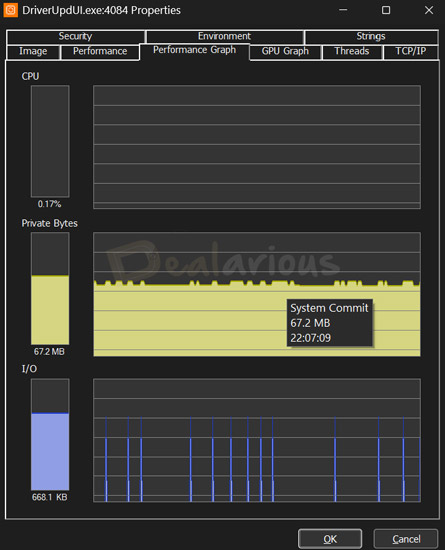
In its idle state, Avast Driver Updater utilized minimal to no CPU resources and leveraged upto 67.2 MB of RAM.
Scanning
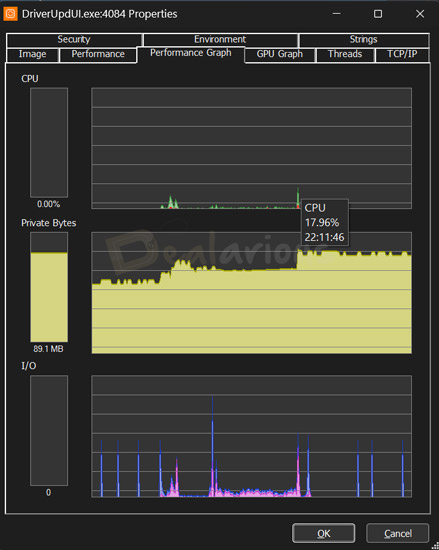
During the scanning process, the program used CPU resources as high as 17.96%, and the RAM consumption increased to 94.6MB.
Driver Booster
Idle State
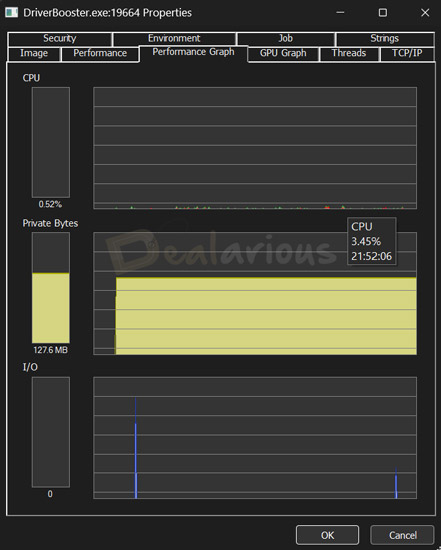
Driver Booster's CPU utilization was similar to Driver Updater's, and the RAM consumption was 127.6MB, constant.
Scanning
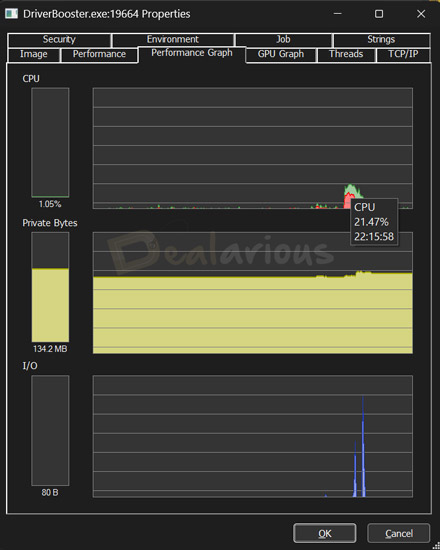
During the scanning process, Driver Booster's CPU usage spiked upto only 21.47% and the RAM usage at 134.2MB.
DRAW
Performance Verdict
Verdict: Both are lightweight, with Avast using less memory and Driver Booster using slightly more CPU during scans. Still, neither slowed down my system. Hence, I declare this segment a draw.
Customer Support
Both tools offer sufficient customer support options. These include knowledge bases (for license inquiry, activation, renewal, etc.), FAQs, and human assistance. However, having multiple support channels is not enough.
Avast takes the lead by offering a Live Chat option. A helpful integration that allows you to quickly connect to a support agent in case of an emergency. Their replies are prompt, and they try to resolve your queries as efficiently as possible.
Meanwhile, Driver Booster is limited to email support. Although helpful, the problem comes with a delayed response. They can take from a day to two to respond to your queries. It can feel like a long wait, especially if you are dealing with some serious driver-related issues.
Avast Cleanup
Support Verdict
By offering 24/7 live chat and call support, Avast wins the customer support segment.
Privacy & Data Sharing
This is one area where both tools could do better.
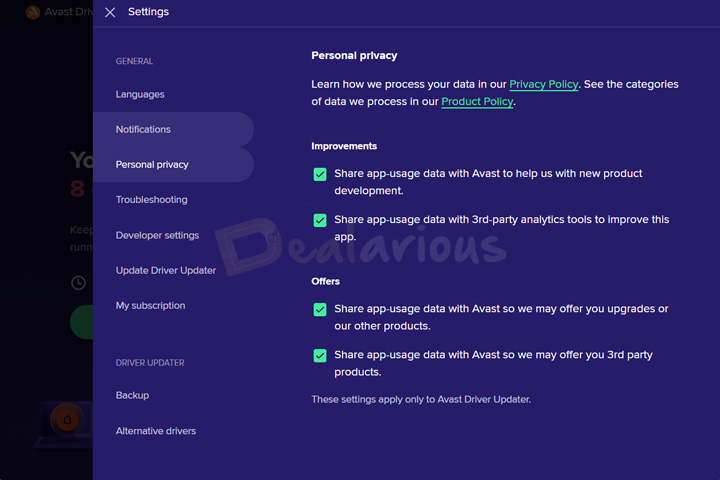
Avast Driver Updater: When you install it, there’s no warning about privacy settings. Inside the app, you’ll find that several data-sharing options are turned on by default. These include sending app-usage data back to Avast, sharing with 3rd-party analytics, and even using your data for product offers. You can switch them off in Settings -> Personal Privacy, but most people won’t notice unless they dig around. That feels a bit sneaky.
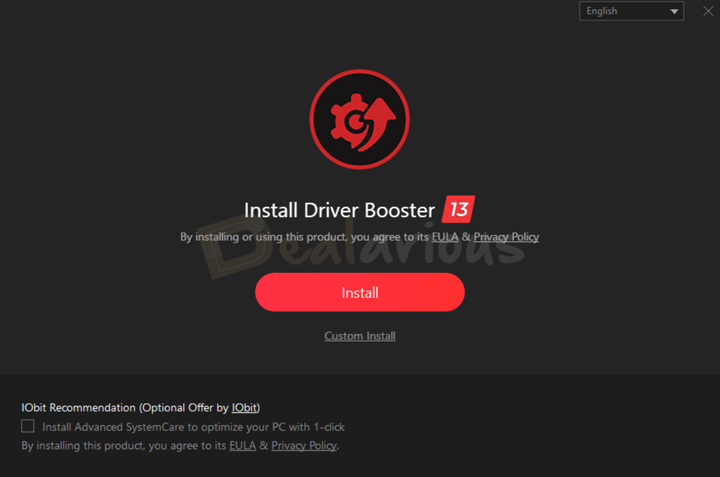
IObit Driver Booster: The installer is more upfront. It tries to bundle extras like Advanced SystemCare, iTop VPN, or Screen Recorder, but you can untick them. You also get a choice to say no to offers. At least you see it during setup, which is more transparent.
IObit Driver Booster
Privacy & Data Sharing Verdict
Avast hides data sharing inside settings, while IObit shows offers upfront. I prefer IObit’s transparency.
Quick Verdict: Avast Driver Updater Vs IObit Driver Booster
- In the Avast Driver Updater vs IObit Driver Booster showdown, IObit stood out by offering a well-organized interface, flexible customization options, WHQL-certified drivers, and multiple additional tools to enhance system performance further. It is a solid choice if you are considering a feature-rich tool with a sense of reliability.
- Avast Driver Updater also serves as a dependable choice for those looking for a simple yet powerful driver updater program. However, it falls short on additional tools and advanced customization options, unlike Driver Booster.
IObit Driver Booster
Winner Declared
Alternatives
If you're not impressed with either Avast Driver Updater or IObit Driver Booster, these are some widely trusted alternatives that offer capable driver updating solutions with their own advantages.
CCleaner Pro Driver Updater
CCleaner is widely known for its PC optimization capabilities. Over time, the program has included a driver updater feature that goes beyond basic system cleanup and aims to enhance overall system performance. Unlike Avast and IObit, the driver updater is not offered as a standalone app. It rather comes as a part of CCleaner Pro.
With a driver database of more than 110 million drivers, it can effectively detect and update outdated drivers and fix recurring system issues. To get a deeper insight into the program's capabilities, read our CCleaner Pro review. Using our CCleaner Pro coupons, you can get it at a much discounted price.
AVG Driver Updater
AVG Driver Updater is another noteworthy driver utility that gives strong competition to both Avast Driver Updater and IObit Driver Booster. With a 50 million+ driver database, the program offers a reliable and user-friendly way to keep your PC drivers updated and free from malfunctions.
As the program is built on the same core technology as Avast's, it doesn't differ much in features. However, it is particularly suited for those who are loyal to the AVG ecosystem. It is reasonably priced and you can save more with our AVG Driver Updater coupons.
FAQs: Avast Driver Updater vs IObit Driver Booster
Is Driver Booster safe to use?
A. Yes, Driver Booster is safe to use. In my end, the Bitdefender antivirus engine didn't find any issues with the program, both during installation and usage. However, to avoid any risks, always download the programs from their official website.
Which Tool Is Better for Gamers?
A. IObit Driver Booster is a powerful driver updater tool that includes a dedicated Game Booster feature to enhance your gaming performance.
Can I use both tools together?
A. You can use both tools, but it is recommended to use just one to avoid conflicts.
Do I need a driver updater tool if Windows updates drivers automatically?
A. Yes, while Windows does update some drivers automatically, it often misses optional or specific manufacturer updates. A tool like Driver Booster or Avast Driver Updater ensures more complete and up-to-date coverage, especially for gaming or niche hardware.
What’s the difference between Avast Driver Updater and IObit Driver Booster?
A. The main difference lies in features and flexibility. IObit Driver Booster offers WHQL-certified drivers, game boosting tools, and better customization. Avast Driver Updater is more minimal and stable, but lacks advanced extras.
Conclusion
Both Avast Driver Updater and IObit Driver Booster deliver on their promise of keeping drivers updated. Avast is the safer pick if you prefer a simple tool from a trusted brand. On the other hand, Driver Booster goes further with WHQL-certified drivers, game boosting, and handy repair tools.
In my testing, either works fine for everyday users. But if you want flexibility and a feature-rich updater, Driver Booster is the better choice.

She reviews software at Dealarious, mostly recovery and productivity tools, which she tries out herself. Her goal is to keep things simple so readers don’t waste hours figuring out what works. Over the years, she has tested dozens of apps and learned that small details often make the biggest difference.
When she isn’t testing programs, you’ll usually find her hiking in the mountains or enjoying the rain. She believes good tech should quietly make life easier, not more complicated.